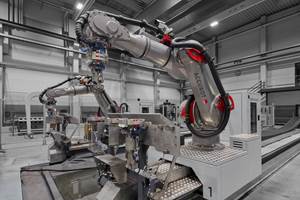Other fiber options
Quartz fibers, while more expensive than glass, have lower density, higher strength and higher stiffness than E-glass, and about twice the elongation-to-break, making them a good choice where durability is a priority. Quartz fibers also have a near-zero CTE; they can maintain their performance properties under
Quartz fibers, while more expensive than glass, have lower density, higher strength and higher stiffness than E-glass, and about twice the elongation-to-break, making them a good choice where durability is a priority. Quartz fibers also have a near-zero CTE; they can maintain their performance properties under continuous exposure to temperatures as high as 1050°C/1920°F and up to 1250°C/2280°F for short time periods. Quartz fibers possess significantly better electromagnetic properties than glass, a plus when fabricating parts like aircraft radomes.
Ceramic fibers offer high to very high temperature resistance but low impact resistance and relatively poor room-temperature properties. Typically much more expensive than other fibers, ceramic, like quartz, is the fiber of choice when its advantages justify the extra cost. One application of ceramic fibers is for flame-resistant veil material in laminates for aircraft interiors, which must withstand 1093°C/2000°F for at least 15 minutes without flame penetration.
PBO is a relatively new fiber, with modulus and tensile strength almost double that of aramid fiber and a decomposition temperature almost 100°C/212°F higher. Suitable for high-temperature applications, it is currently used in protective ballistic armor, sporting goods, insulation and tire reinforcements.
Also a newcomer, basalt fibers are inexpensive, golden brown-colored fibers, similar to glass, and currently produced primarily in Russia and Ukraine. Basalt exhibits better chemical and alkali resistance than glass, promising an additional choice for use in reinforcing concrete in infrastructure applications. Kamenny Vek (Dubna, Russia), Technobasalt (Kyiv, Ukraine) and Hengdian Group Shanghai Russia & Gold Basalt Fibre Co. (Shanghai, China) are three of the growing number of basalt fiber and basalt fiber product distributors.
Boron fibers are five times as strong and twice as stiff as steel. They are made by a chemical vapor deposition process in which boron vapors are deposited onto a fine tungsten or carbon filament. Boron provides strength, stiffness and light weight, and possesses excellent compressive properties and buckling resistance. Uses for boron composites range from sporting goods, such as fishing rods, golf club shafts, skis and bicycle frames, to aerospace applications as varied as aircraft empennage skins, space shuttle truss members and prefabricated aircraft repair patches.
Fiber hybrids capitalize on the best properties of various fiber types, and may reduce raw material costs. Hybrid composites that combine carbon/aramid or carbon/glass fibers have been used successfully in ribbed aircraft engine thrust reversers, telescope mirrors, driveshafts for ground transportation and infrastructure column-wrapping systems.
Natural fibers - abaca, coconut, flax, hemp, jute, kenaf and sisal are the most common - are derived from the bast or outer stem of certain plants. Natural fibers are enjoying increased use because of their "green"attributes (less energy to produce), light weight, recyclability, good insulation properties and carbon dioxide neutrality (when burned natural fibers give off no more carbon dioxide than consumed while growing). Natural fibers also have the lowest density of any structural fiber but possess sufficient stiffness and strength for some applications.
The automotive industry, in particular, is using these fibers in traditionally unreinforced plastic parts and even employs them as an alternative to glass fibers. Natural fiber-reinforced thermosets and thermoplastics are most often found in door panels, package trays, seat backs and trunk liners in cars and trucks. European fabricators hold the lead in use of these materials, in part because regulations now require their automobile components to be recyclable. Natural fibers can be incorporated into molded or extruded parts and, more recently, have been used in the direct long fiber injection (D-LFT) process where kenaf, flax and natural fiber/glass hybrids are used to reinforce polypropylene.
Related Content
Rocket Lab begins installation of large AFP machine for rocket production
The 99-ton AFP machine, custom-designed and built by Electroimpact, is claimed to be the largest of its kind, expecting to save around 150,000 manufacturing hours in the Neutron rocket’s production process.
Read MoreNew GTL breakthrough in composite tubing for liquid hydrogen in aircraft and space vehicles
Tests versus stainless steel tubing show 10 times faster chill down, fuel flow in 2 seconds and less boil-off for significantly faster fueling and refueling of LH2-powered space vehicles, aircraft and trucks.
Read MoreAutomated robotic NDT enhances capabilities for composites
Kineco Kaman Composites India uses a bespoke Fill Accubot ultrasonic testing system to boost inspection efficiency and productivity.
Read MoreRevolutionizing space composites: A new era of satellite materials
A new approach for high volumes of small satellite structures uses low-CTE, low-cost CFRP cellular core, robust single-ply skins and modular panel systems to cut lead time, labor and cost for reflectors, solar arrays and more.
Read MoreRead Next
Ultrasonic welding for in-space manufacturing of CFRTP
Agile Ultrasonics and NASA trial robotic-compatible carbon fiber-reinforced thermoplastic ultrasonic welding technology for space structures.
Read MoreCeramic matrix composites: Faster, cheaper, higher temperature
New players proliferate, increasing CMC materials and manufacturing capacity, novel processes and automation to meet demand for higher part volumes and performance.
Read MoreScaling up, optimizing the flax fiber composite camper
Greenlander’s Sherpa RV cab, which is largely constructed from flax fiber/bio-epoxy sandwich panels, nears commercial production readiness and next-generation scale-up.
Read More








